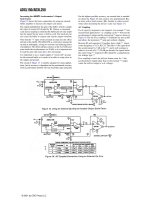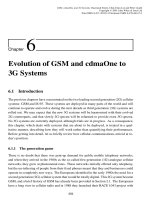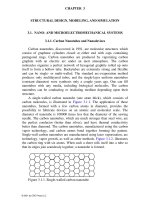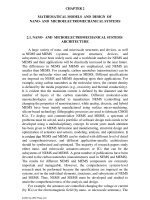Nano and Microelectromechanical Systems P6
Bạn đang xem bản rút gọn của tài liệu. Xem và tải ngay bản đầy đủ của tài liệu tại đây (765.06 KB, 36 trang )
CHAPTER 4
CONTROL OF NANO- AND MICROELECTROMECHANICAL
SYSTEMS
4.1. FUNDAMENTALS OF ELECTROMAGNETIC RADIATION AND
ANTENNAS IN NANO- AND MICROSCALE
ELECTROMECHANICAL SYSTEMS
The electromagnetic power is generated and radiated by antennas. Time-
varying current radiates electromagnetic waves (radiated electromagnetic
fields). Radiation pattern, beam width, directivity, and other major
characteristics can be studied using Maxwell’s equations, see Section 2.2. We
use the vectors of the electric field intensity E
, electric flux density D,
magnetic field intensity H, and magnetic flux density B. The constitutive
equations are
ED ε=
and
HB µ=
where
ε
is the permittivity;
µ
is the permiability.
It was shown in Section 2.2 that in the static (time-invariant) fields,
electric and magnetic field vectors form separate and independent pairs. That
is, E and D are not related to H and B, and vice versa. However, for time-
varying electric and magnetic fields, we have the following fundamental
electromagnetic equations
t
tzyx
tzyx
∂
∂
µ
),,,(
),,,(
H
E −=×∇
,
),,,(
),,,(
),,,(),,,( tzyx
t
tzyx
tzyxtzyx
J
E
EH ++=×∇
∂
∂
εσ
,
ε
ρ ),,,(
),,,(
tzyx
tzyx
v
=⋅∇ E
,
0),,,( =⋅∇ tzyxH
,
where J is the current density, and using the conductivity
σ
, we have
EJ σ=
;
v
ρ
is the volume charge density.
The total current density is the sum of the source current J
S
and the
conduction current density
Eσ
(due to the field created by the source J
S
).
Thus,
EJJ σ+=
Σ S
.
The equation of conservation of charge (continuity equation) is
∫∫
−=⋅
v
v
s
dv
dt
d
d ρ
sJ
,
and in the point form one obtains
t
tzyx
tzyx
v
∂
∂
−=⋅∇
),,,(
),,,(
ρ
J
.
© 2001 by CRC Press LLC
Therefore, the net outflow of current from a closed surface results in
decrease of the charge enclosed by the surface.
The electromagnetic waves transfer the electromagnetic power. That is,
the energy is delivered by means of electromagnetic waves. Using equations
t∂
∂
µ
H
E −=×∇
and
J
E
H +=×∇
t∂
∂
ε
,
we have
+⋅−⋅−=×∇⋅−×∇⋅=×⋅∇ J
E
E
H
HHEEHHE
tt ∂
∂
ε
∂
∂
µ)()()(
.
In a media, where the constitute parameters are constant (time-invariant),
we have the so-called point-function relationship
( )
22
2
1
2
2
1
)( EHE
t
σµε
∂
∂
−+−=×⋅∇ HE
.
In integral form one obtains
( )
EHE
sHE
of presence in the
dissipatedpower ohmic
2
field magnetic and field electric the
in storedenergy of change of ratetime
2
2
1
2
2
1
.)(
∫∫∫
−+−=⋅×
−
vvs
dvEdvHE
t
d σµε
∂
∂
The right side of the equation derived gives the rate of decrease of the
electric and magnetic energies stored minus the ohmic power dissipated as heat
in the volume v. The pointing vector, which is a power density vector,
represents the power flows per unit area, and
HEP ×=
.
Furthermore,
( )
∫∫∫∫
++=⋅=⋅×
vv
HE
ss
dvdvww
t
dd
σ
ρ
∂
∂
volumeenclosed theleavingpower
)( sPsHE
,
where
2
2
1
Ew
E
ε=
and
2
2
1
Hw
H
µ=
are the electric and magnetic energy
densities;
22
1
JE
σ
σρ
σ
==
is the ohmic power density.
The important conclusion is that the total power transferred into a closed
surface s at any instant equals the sum of the rate of increase of the stored
electric and magnetic energies and the ohmic power dissipated within the
enclosed volume v.
If the source charge density
),,,( tzyx
v
ρ
and the source current density
),,,( tzyxJ
vary sinusoidally, the electromagnetic field also vary
sinusoidally. Hence, we have deal with the so-called time-harmonic
electromagnetic fields. The sinusoidal time-varying electromagnetic fields will
be studied. Hence, the phasor analysis is applied. For example,
zzyyxx
EEE arararrE )()()()( ++=
.
© 2001 by CRC Press LLC
The electric field intensity components are the complex functions. In
particular,
ImRe
)(
xxx
jEEE +=r
,
ImRe
)(
yyy
jEEE +=r
,
ImRe
)(
zzz
jEEE +=r
.
For the real electromagnetic field, we have
tEtEtE
xxx
ωω sin)(cos)(),(
ImRe
rrr −=
.
One obtains the time-harmonic electromagnetic field equations. In
particular,
•
Faraday’s law
HE ωµ
j
−=×∇
,
•
generalized Amphere’s law
JEJEEH
+
+=++=×∇ ε
ω
σ
ωωεσ
j
jj
,
•
Gauss’s law
ε
ω
σ
ρ
+
=⋅∇
j
v
E
,
•
Continuity of magnetic flux
0=⋅∇ H
,
•
Continuity law
v
j
ωρ−=⋅∇ J
, (4.1.1)
where
+ε
ω
σ
j
is the complex permittivity. However, for simplicity we will
use
ε
keeping in mind that the expression for the complex permittivity
ε
ω
σ
+
j
must be applied.
T
he electric field intensity E
, electric flux density D, magnetic field
intensity H, magnetic flux density B, and current density J are complex-valued
functions of spatial coordinates.
From the equation (4.1.1) taking the curl of
HE ωµj−=×∇
, which is
rewritten as
BE ωj−=×∇
, and using
JDH +=×∇ ωj
, one obtains
JEEE ωµµεω jk
v
−===×∇×∇
22
,
where k
v
is the wave constant
µεω=
v
k
, and in free space
c
k
v
ω
εµω ==
000
because the speed of light is
00
1
εµ
=c
,
sec
m
8
103×=c
.
The wavelength is found as
µεω
ππ
λ
22
==
v
v
k
,
and in free space
ω
ππ
λ
c
k
v
v
22
0
0
==
.
© 2001 by CRC Press LLC
Using the magnetic vector potential A, we have
AB ×∇=
.
Hence,
0)( =+×∇ AE ωj
,
and thus
ËAE −∇=+ ωj
,
where
Ë
is the scalar potential.
To guarantee that
JDH +=×∇ ωj
holds, it is required that
JEAAAH µωµεµ +=∇−⋅∇∇=×∇×∇=×∇ j
2
.
Therefore, one finally finds the equation needed to be solved
JËAAA µωµε −+⋅∇∇=+∇ )(
22
jk
v
.
Taking note of the Lorentz condition
ËA ωµεj−=⋅∇
, one obtains.
JAA µ−=+∇
22
v
k
.
Thus, the equation for
Ë
is found. In particular,
ε
ρ
v
v
k −=+∇ ËË
22
.
The equation for the magnetic vector potential is found solving the
following inhomogeneous Helmholtz equation
JAA µ−=+∇
22
v
k
.
The expression for the electromagnetic field intensity, in terms of the
vector potential, is
ωµε
ω
j
j
A
AE
⋅∇∇
+−=
.
To derive E, one must have A. The Laplacian for A in different coordinate
systems can be found. For example, we have
xxvx
JAkA µ−=+∇
22
,
yyvy
JAkA µ−=+∇
22
,
zzvz
JAkA µ−=+∇
22
.
It was shown that the magnetic vector potential and the scalar potential
obey the time-dependent inhomogeneous wave equation
),(),(
2
2
2
tFt
t
k rr −=Ω
∂
∂
−∇
.
The solution of this equation is found using Green’s function as
∫∫∫∫
−−−=Ω '')';'()','(),( τddtttGtFt rrrr
,
where
( )
''
'4
1
)';'( rr
rr
rr −−−
−
−=−− kttttG δ
π
.
The so-called retarded solution is
© 2001 by CRC Press LLC
∫∫∫
−
−−
−=Ω '
'
)'','(
),( τd
ktF
t
rr
rrr
r
.
For sinusoidal electromagnetic fields, we apply the Fourier analysis to
obtain
∫∫∫
−
−=Ω
−−
')'(
'4
1
)(
'
τ
π
dF
e
v
jk
r
rr
r
rr
.
Thus, we have the expressions for the phasor retarded potentials
dv
e
v
jk
v
∫
−
=
−−
)'(
'4
)(
'
rJ
rr
A
rr
r
π
µ
,
dv
e
v
jk
v
∫
−
=
−−
)'(
'4
1
)(
'
r
rr
Ë
rr
r
ρ
πε
.
Example 4.1.1.
Consider a short (dl) thin filament of current located in the origin, see
Figure 4.1.1. Derive the expressions for magnetic vector potential and
electromagnetic field intensities.
Figure 4.1.1. Current filament in the spherical coordinate system
Solution.
The magnetic vector potential has only a z component, and thus, from
JAA µ−=+∇
22
v
k
,
we have
ds
i
JAkA
zzvz
µµ −=−=+∇
22
,
where ds is the cross-sectional area of the filament.
x
y
z
idl
θ
φ
r
φ
a
r
a
θ
a
© 2001 by CRC Press LLC
Taking note of the spherical symmetry, we conclude that the magnetic
vector potential A
z
is not a function of the polar and azimuth angles
φθ and
. In
particular, the following equation results
0
1
22
2
=+
∂
∂
∂
∂
zv
z
Ak
r
A
r
r
r
.
It is well-known that the solution of equation
0
2
2
2
=+ ψ
ψ
ψ
v
k
d
d
has two
components. In particular,
rjk
v
e
(outward propagation) and
rjk
v
e
−
(inward
propagation). The inward propagation is not a part of solution for the filament
located in the origin. Thus, we have
rjktj
v
aert
−
=
ω
ψ ),(
(outward propagating spherical wave).
In free space, we have
)/(
),(
crtj
aert
−
=
ω
ψ
.
Substituting
r
A
z
ψ
=
, one obtains
c
rj
z
e
r
a
rA
ω
−
=)(
.
To find the constant a, we use the volume integral
∫∫∫∫
−−=⋅∇=∇
v
z
v
z
s
drz
v
z
dvJdvA
c
ddrAdvA
0
2
2
22
sin
µ
ω
φθθ
a
,
where the differential spherical volume is
drddrdv
d
φθθsin
2
=
; r
d
is the
differential radius.
Making use of
r
c
j
z
rz
e
r
a
r
c
j
r
A
A
ω
ω
−
+−=
∂
∂
=⋅∇
2
1a
,
we have
idladdaer
c
j
d
d
r
c
j
d
r
0
2
0 0
0
4sin1lim µπφθθ
ω
ππ
ω
−=−=
+−
∫∫
−
→
,
one has
π
µ
4
0
idl
a =
.
Thus, the following expression results
c
rj
z
e
r
idl
rA
ω
π
µ
−
=
4
)(
0
.
Therefore, the final equation for the magnetic vector potential (outward
propagating spherical wave) is
z
c
rj
e
r
idl
r aA
ω
π
µ
−
=
4
)(
0
.
© 2001 by CRC Press LLC
From
θθ
θ
sincos
aaa −=
rz
, we have
)sincos(
4
)(
0
θθ
π
µ
θ
ω
aaA −=
−
r
c
rj
e
r
idl
r
The magnetic and electric field intensities are found using
AB ×∇=
and
ωµε
ω
j
j
A
AE
⋅∇∇
+−=
.
Then, one finds
φ
ω
ω
π
θ
µ
aAH
c
rj
e
r
cr
j
r
idl
rr
−
+=×∇=
2
0
1
4
sin
)(
1
)(
,
.
1
sin
4
1
cos
4
)(
322
2
0
0
32
0
0
θ
ω
ω
ωω
θ
πω
ε
µ
ω
θ
πω
ε
µ
a
aE
c
rj
r
c
rj
e
rcr
j
rc
cidlj
e
rcr
j
cidlj
r
−
−
++−−
+=
The intrinsic impedance is given as
0
0
0
ε
µ
=Z
, and
0
0
0
0
1
µ
ε
==
Z
Y
.
Near-field and far-field electromagnetic radiation fields can be found,
simplifying the expressions for H(r) and E(r).
For near-field, we have
φ
ω
π
θω
µ
aAH
c
rj
e
cr
idl
jrr
−
=×∇=
2
0
4
sin
)(
1
)(
and
.sin
4
)(
2
0
0
θ
θ
π
ω
ε
µ
aE
rc
cidl
jr =
The complex Pointing vector can be found as
)()(
*
2
1
rr HE ×
.
The following expression for the complex power flowing out of a sphere
of radius r results
( )
π
ωµ
π
εµµω
1212
)()(
22
0
22
000
2
*
2
1
dlik
dli
drr
v
s
==⋅×
∫
sHE
.
The real quality is found, and the power dissipated in the sense that it
travels away from source and cannot be recovered.
© 2001 by CRC Press LLC
Example 4.1.2.
Derive the expressions for the magnetic vector potential and
electromagnetic field intensities for a magnetic dipole (small current loop)
which is shown in Figure 4.1.2.
Figure 4.1.2. Current loop in the xy plane
Solution.
The magnetic dipole moment is equal to the current loop are times current.
That is,
zz
Mir aaM ==
2
0
π
.
For the short current filament, it was derived in Example 4.1.1 that
z
c
rj
e
r
idl
r
aA
ω
π
µ
−
=
4
)(
0
.
In contrast, we have
∫
=
l
dl
r
i
'
1
4
0
π
µ
A
.
The distance between the source element dl and point
),,(
2
π
θrO
is
denoted as r’. It should be emphasized that the current filament is lies in the xy
plane, and
φφφφ
φ
drdrdl
yx
00
)cossin( aaa
+−==
.
Thus, due to the symmetry
∫
−
=
2/
2/
00
'
sin
2
π
π
φ
φ
φ
π
µ
d
r
ir
aA
,
where using the trigonometric identities one finds
φθ sinsin2'
0
2
0
22
rrrrr −+=
.
Assuming that
2
0
2
rr >>
, we have
+≈ φθ sinsin1
1
'
1
0
r
r
rr
.
x
y
z
θ
r
'r
0
r
φdir
0
φ
),,(
2
π
θrO
dl
© 2001 by CRC Press LLC
Therefore
.sin
4
sinsinsin1
2
'
sin
2
2
2
00
2/
2/
000
2/
2/
00
θ
µ
φφφθ
π
µ
φ
φ
π
µ
φ
π
π
φ
π
π
φ
r
ir
d
r
r
r
ir
d
r
ir
aa
aA
=
+=
=
∫
∫
−
−
Having obtained the explicit expression for the
vector potential, the
magnetic flux density is found. In particular,
)sincos2(
4
sin
4
3
2
00
2
2
00
θθ
µ
θ
µ
θφ
aaaAB +=×∇=×∇=
r
r
ir
r
ir
.
Taking note of the expression for the magnetic dipole moment
z
ir aM
2
0
π=
, one has
r
rr
ir
aMaA ×==
2
0
2
2
00
4
sin
4 π
µ
θ
µ
φ
.
It was shown that using
∫
=
l
dl
r
i
'
1
4
0
π
µ
A
, the desired results are obtained.
Let us apply
∫
−
=
l
r
c
j
dl
r
e
i
'4
'
0
ω
π
µ
A
.
From
r
c
jr
c
j
err
c
je
ωω
ω
−−
−−≈ )'(1
'
, we have
( )
θ
π
µ
π
µ
ω
ω
φ
ω
ω
sin1
4
'
)]'(1[
4
2
00
r
c
j
c
l
r
c
j
c
erj
r
M
dl
r
errj
i
−
−
+=
−−
=
∫
aA
.
Therefore, one finds
θ
π
ωµ
ω
ω
ω
φ
sin
11
4
2
2
3
0
2
2
r
c
j
c
c
e
r
rj
c
M
jE
−
−=
,
θ
π
ε
µ
ωµ
ω
ωω
cos
11
4
2
32
0
0
2
3
0
3
3
2
2
r
c
j
cc
r
e
rjr
c
M
jH
−
+=
,
θ
π
ε
µ
ωµ
ω
ωω
ω
θ
sin
111
4
32
0
0
2
3
0
3
3
2
2
r
c
j
cc
c
e
rjr
rj
c
M
jH
−
−−−=
.
© 2001 by CRC Press LLC
The electromagnetic fields in near- and far-fields can be straightforwardly
derived, and thus, the corresponding approximations for the
φ
E
,
r
H
and
θ
H
can be obtained.
Let the current density distribution in the volume is given as
)(
0
rJ
, and
for far-field from Figure 4.1.3 one has
0
'
rrr −≈
.
Figure 4.1.3. Radiation from volume current distribution
The formula to calculate far-field magnetic vector potential is
dvee
r
v
jkrjk
vv
∫
−−
=
0
)(
4
)(
0
r
rJA
r
π
µ
,
and the electric and magnetic field intensities are found using
ωµε
ω
j
j
A
AE
⋅∇∇
+−=
and
AB ×∇=
.
We have
[ ]
dvee
r
Zjk
v
jk
rr
rjk
vv
vv
∫
−−
−⋅=
0
)()(
4
)(
00
r
rJarJaE
r
π
,
)()( rEaH
r
×=
rv
Y
.
Example 4.1.3.
Consider the half-wave dipole antenna fed from a two-wire transmission
line, as shown in Figure 4.1.4 The antenna is one-quarter wavelength; that is,
vv
z λλ
4
1
4
1
≤≤−
. The current distribution is
zkizi
v
cos)(
0
=
. O
btain the
equations for electromagnetic field intensities and radiated power.
x
z
0
r
r
r
a
y
'r
J
Source
© 2001 by CRC Press LLC
Figure 4.1.4. Half-wave dipole antenna
Solution.
The wavelength is given as
µεω
ππ
λ
22
==
v
v
k
, and in free space we
have
ω
ππ
λ
c
k
v
v
22
0
0
==
.
It was emphasized that and
000
εµω=
v
k
.
Making use of
[ ]
dvee
r
Zjk
v
jk
rr
rjk
vv
vv
∫
−−
−⋅=
0
)()(
4
)(
00
r
rJarJaE
r
π
,
we have the following line integral
[ ]
∫
−−
−⋅=
l
jk
lrlr
rjk
vv
dlelie
r
Zjk
vv 0
)()(
4
)(
r
aaaaE
r
π
,
where
l
a
is the unit vector in the current direction.
Then,
.
sin2
)coscos(
cos)cos(
4
)(
2
1
0
cos
0
4
1
4
1
θ
θ
λ
λ
θπ
θπ
θ
π
a
aaE
r
rjk
v
zjk
vzr
rjk
vv
v
v
v
v
v
e
r
ijZ
dzzeke
r
iZjk
−
−
−
−
=
−=
∫
Having found the magnetic field intensity as
φφφ
θπ
θπ
aarEaH
r
rjk
rv
v
e
r
ji
HY
−
==×=
sin2
)coscos(
)()(
2
1
0
,
the
power flux per unit area is
( )
θπ
θπ
φφ
222
2
1
2
0
2
0
*
2
1
*
2
1
sin8
)cos(cos
)()(Re
r
Zi
HE
r
==⋅× aHE
rr
,
x
y
z
v
λ
4
1
r
r
a
© 2001 by CRC Press LLC
and integrating the derived expression over the surface
φθθ
θ
θπ
π
ππ
dd
Zi
sin
sin
)cos(cos
8
2
0 0
2
2
1
2
2
0
2
0
∫∫
, the total radiated power is found to
be
2
0
6.36 i
.
If the current density distribution is known, the radiation field can be
found. Using Maxwell’s equations, using the electric and magnetic vector
potentials A
E
and A
H
, we have the following equations
( )
EEv
k JA µ−=+∇
22
,
( )
HHv
k JA ε−=+∇
22
,
HEE
j
j AAAE ×∇−⋅∇∇+−=
εωµε
ω
11
,
EHH
j
j AAAH ×∇−⋅∇∇+−=
µωµε
ω
11
.
The solutions are
rrJA
r
r
dee
r
v
E
jkrjk
E
vv
∫
−
= )(
4
)(
π
µ
,
rrJA
r
r
dee
r
v
H
jkrjk
H
vv
∫
−
= )(
4
)(
π
ε
.
Example 4.1.4.
Consider the slot (one-half wavelength long slot is dual to the half-wave
dipole antenna studied in Example 4.1.3), which is exited from the coaxial
line, see Figure 4.1.5. The electric field intensity in the z-direction is
( )
zlkEE
v
−= sin
0
. Derive the expressions for the magnetic vector potential
and electromagnetic field intensities.
Figure 4.1.5. Slot antenna
x
y
z
Slot
r
( )
zlkE
v
−sin2
:Field
0
l
Slot
© 2001 by CRC Press LLC
Solution.
Using the magnetic current density J
H
, from
∫∫∫∫
⋅−⋅−=⋅=⋅×∇
s
H
sls
ddjdld sJsBEsE ω
,
the boundary conditions for the magnetic current sheet are found as
Hnn
JEaEa −=×−×
21
.
The slot antenna is exited by the magnetic current with strength
( )
zlkE
v
−sin2
0
in the z axis. For half-wave slot we have
( )
zlkii
vH
−= sin
0
, and
( )
HHv
k JA ε−=+∇
22
,
θ
θπ
θπ
ωµε
ω a
A
AH
rjk
H
H
v
e
r
Yi
j
j
j
−
=
⋅∇∇
+−=
sin2
)coscos(
2
1
00
,
.
sin2
)coscos(
2
1
0
φ
θπ
θπ
ε
a
A
E
rjk
H
v
e
r
i
j
−
−=
×∇
−=
,
srJA
r
r
dee
s
jkrjk
H
vv
∫
−
= )(
16
)(
π
ε
.
The boundary condition
( )
zlkE
vxnHn
−×=−=× sin
0
2
1
aaJEa
is
satisfied by the radiated electromagnetic field.
The radiation pattern of the slot antenna is the same as for the dipole
antenna.
References
1. Hayt W. H., Engineering Electromagnetics, McGraw-Hill, New York,
1989.
2. Collin R. E., Antennas and Radiowave propagation,” McGraw-Hill, New
York, 1985.
3. Paul C. R., Whites K. W., and Nasar S. A., Introduction to
Electromagnetic Fields, McGraw-Hill, New York, 1998.
© 2001 by CRC Press LLC
4.2. DESIGN OF CLOSED-LOOP NANO- AND
MICROELECTROMECHANICAL SYSTEMS USING THE
LYAPUNOV STABILITY THEORY
The solution of a spectrum of problems in nonlinear analysis, structural
synthesis, modeling, and optimization of NEMS and MEMS lead to the
development of superior high-performance NEMS and MEMS. In this section,
we address introductory control issues. Mathematical models of NEMS and
MEMS were derived, and the application of the Lyapunov theory is studied as
applied to solve the motion control problem
.
It was illustrated that NEMS and MEMS must be controlled. Nano- and
microelectromechanical systems augment a great number of subsystems, and to
control microscale electric motors, as discussed in previous chapters, power
amplifiers (ICs) regulate the voltage or current fed to the motor windings.
These power amplifiers are controlled based upon the reference (command),
output, decision making, and other variables. Studying the end-to-end NEMS
and MEMS behavior, usually the output is the nano- or microactuator linear
and angular displacements. There exist infinite number of possible NEMS and
MEMS configurations, and it is impossible to cover all possible scenarios.
Therefore, our efforts will be concentrated on the generic results which can be
obtained describing NEMS and MEMS by differential equations. That is, using
the mathematical model, as given by differential equations, our goal is develop
control algorithms to guarantee the desired performance characteristics
addressing the motion control problem (settling time, accuracy, overshoot,
controllability, stability, disturbance attenuation, et cetera).
Several methods have been developed to address and solve nonlinear
design and motion control problems for multi-input/multi-output dynamic
systems. In particular, the Hamilton-Jacobi and Lyapunov theories are found to
be the most straightforward in the design of control laws.
The NEMS and MEMS dynamics is described as
uxBdrxFtx )(),,()(
+=
&
,
)(xHy =
,
u u u x t x
min max
, ( )
≤ ≤ =
0 0
,
(4.2.1)
where x∈X⊂
c
is the state vector; u∈U⊂
m
is the bounded control vector;
r∈R⊂
b
and y∈Y⊂
b
are the measured reference and output vectors; d∈D⊂
s
is the disturbance vector; F(⋅):
c
×
b
×
s
→
c
and B(⋅):
c
→
c
×
m
are jointly
continuous and Lipschitz; H(⋅):
c
→
b
is the smooth map defined in the
neighborhood of the origin, H(0) = 0.
Before engaged in the design of closed-loop systems, which will be based
upon the Lyapunov stability theory, let us study stability of time-varying
nonlinear dynamic systems described by
),()( xtFtx =
&
,
00
)( xtx =
,
0≥t
.
The following Theorem is formulated.
© 2001 by CRC Press LLC









